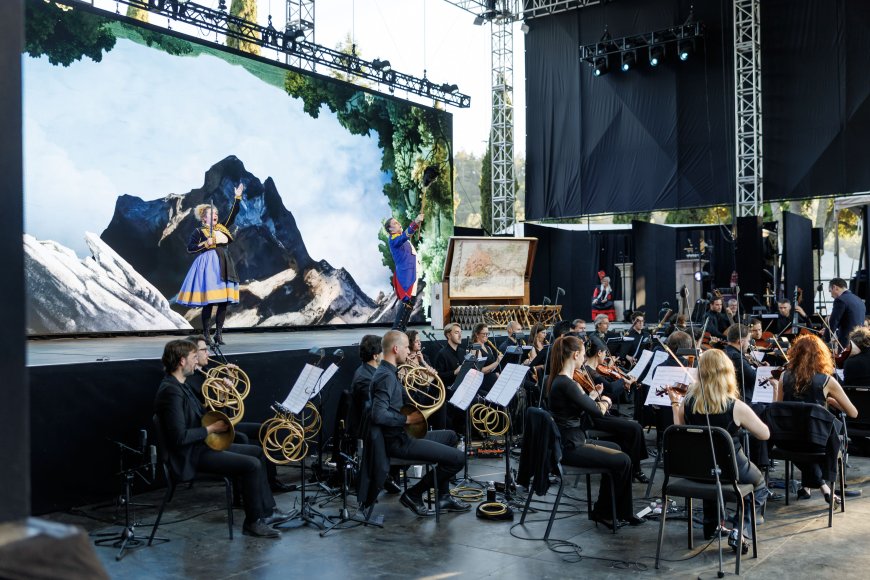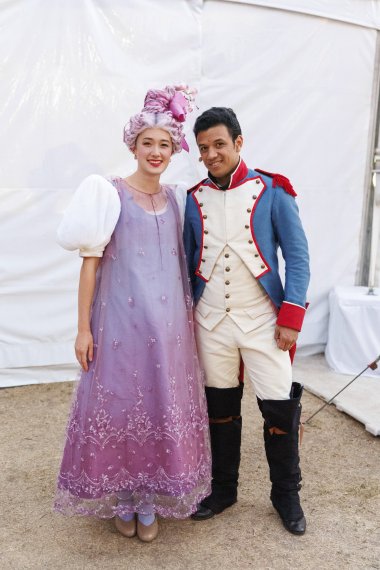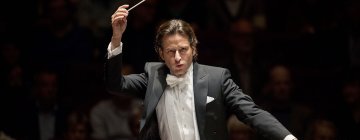
Gaetano Donizetti’s La fille du régiment seems like a grand opera, certainly when you see singers straining to fill a big auditorium. But in Opéra Royal Château de Versailles’s historically informed production, which reached the Festival Napa Valley Stage at Charles Krug Winery on July 18, the show was restored, you might say, to its right size and staged for nimble comedy rather than showstopping vocal moments.
Director Jean-Romain Vesperini’s approach to the opéra comique was apparent from the first scene, when the chorus broke out their dance moves and a statue suddenly animated and walked offstage with a breezy “ta-ta!” Mezzo-soprano Eléonore Pancrazi as the Marquise de Berkenfield then took over, with a winning combination of physical comedy and copious ad-libs in the spoken dialogue, most of them in English for the benefit of the Napa Valley audience. It’s no slight on the other performers to say the show had a lead comedian in Pancrazi. At two points in the second act, the quantity of her ad-libs actually caused a breakdown in the supertitles.
Set in the Tyrolean Alps during the Napoleonic Wars, the show’s story concerns the love between Tonio, a member of the partisan resistance, and Marie, a foundling adopted by an entire French regiment. The couple faces comedic obstacles to their union after Marie is whisked away to a chateau by the Marquise, who recognizes Marie as her long-lost niece and intends to train her as a lady.

Vesperini and the production’s music director, Gaétan Jarry, casted singers with extensive experience in opéra-comique and operetta for Fille. And the lightness of some of those voices suited the music well. Sahy Ratia was a particularly felicitous choice for Tonio. The character’s showpiece aria, “Ah, mes amis,” with it nine high Cs, has become a tenor torture test, but in this performance it glowed with the easy exuberance of youth, making it clear that Donizetti didn’t imagine someone muscling the high notes in full chest voice. Ratia was delightful, and, like his comrades, delivered the dialogue with idiomatic expression and perfect diction.
As Marie, Manon Lamaison was sharply comic, but also showed off a lovely lyric soprano, which she used to bring home the score’s emotional moments. She was the show’s fighting spirit, and, in another surprise, led the cast in one chorus of the “Marseillaise,” interpolated as a rousing, applause-inducing send-off.
In addition to her comedy, Pancrazi has a supple, radiant voice. And as Sulpice, Jean-François Lapointe used his big baritone to emphasize the character’s earthiness, which made his overt sentimentality and awed admiration for the Marquise funnier. Jean-Gabriel Saint Martin played the Marquise’s steward, Hortensius, with equal measures of fawning and griping.
The 41 musicians in the pit, playing period instruments, were worth their weight in gold, considering that the performance was outdoors. The chorus, selected from local singers, performed as if they had been with the show from the beginning, and Jarry led the production with brio.
As SFCV reported, Roland Fontaine and Nimblist’s original sets, designed for Versailles’ Baroque theater, were computer rendered and projected on a back screen for this performance. If one missed the full three-dimensional effect, Étienne Guiol’s video design compensated, making cute commentary on the passing action.

In addition to paying for production transport, the well-funded Festival Napa Valley hired 50 technicians to run everything from sound synchronization (done as well as at a major stadium concert) to capturing the event on video. The Festival continues to offer its performances to the public on a pay-what-you-can basis, with the suggested general admission price only $35.

